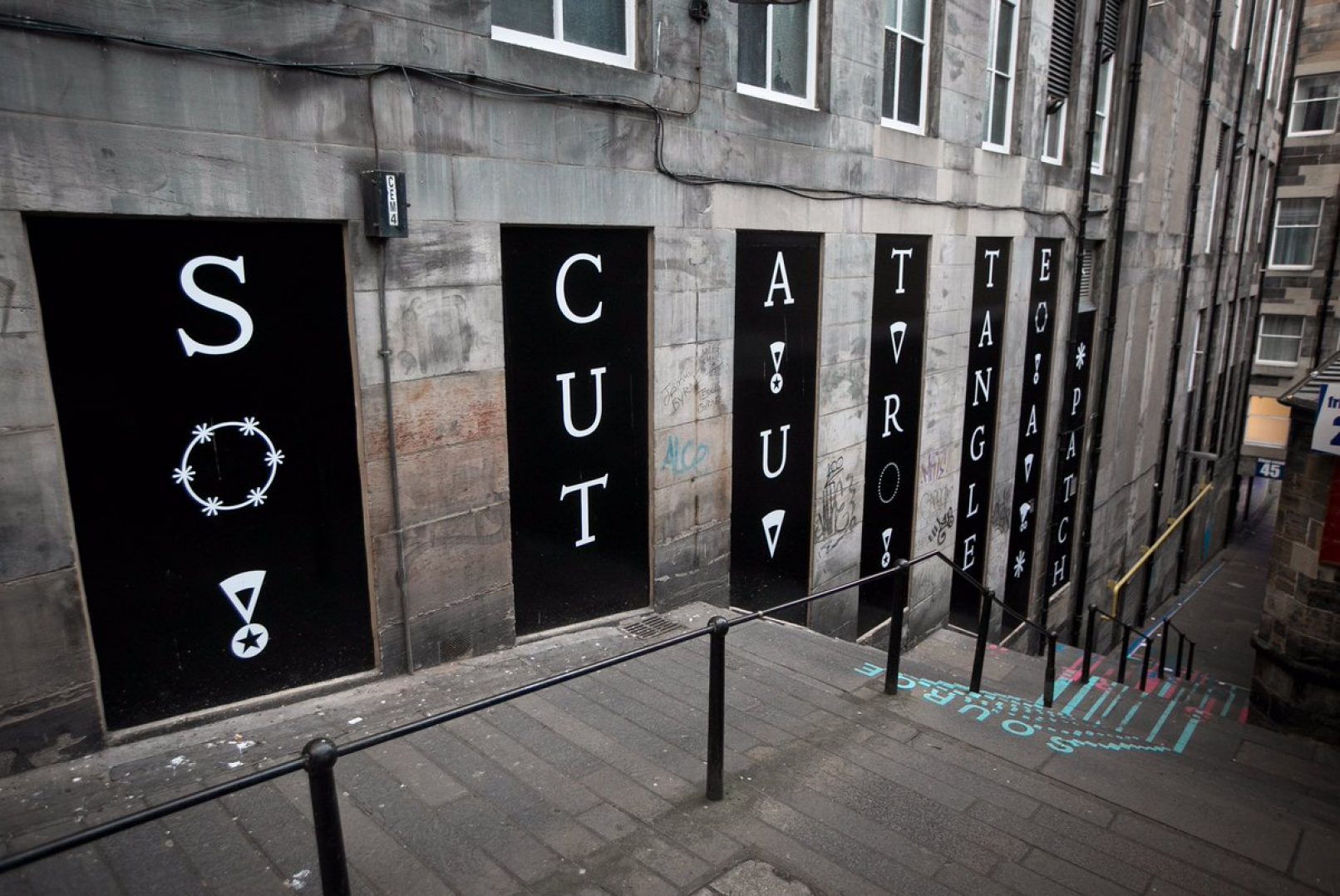open close
2017
Three installations for the Open Close project in Edinburgh in Summer 2017.
+++
Lines of Flight
With Tommy Perman
Two text pieces have been installed through the Open Closes. Each use words which resonate with the dynamics of human movement, architectural design and urban ecologies across the site.
The text on the wall of Carrubbers Close is interspersed with marker symbols inspired partly by those used in Abercrombie and Plumstead’s 1949 radical plans for the redesign of Edinburgh city centre, and partly by the history of early balloon flight from nearby Abbeyhill. In 1784, James Tytler completed Britain’s first hot-air balloon flight, taking off around half a mile east of the closes, and landing in Restalrig. The forms of these ‘balloon’ symbols resonate with contemporary digital map place-pins and GPS waypoints; a nod to the sense of flight and possibility in the multiple (re)mappings of these paths through the Old Town by Open Close collaborators.
In Chalmers Close, another text piece ‘nip/nick/niche’ on a replacement brick on a pavement gap draws attention to the ‘gap site’ flanked by the closes; an unruly urban ecosystem seeded by economic speculation, and grown by subsequent undevelopment. What has been left is a micro-niche of green space in ruderal health; an island ecology cut off by high tenements and hotels. Perhaps the most appropriate way to access this site, then, would be through another balloon landing?
Whether read as instructions or descriptions, the three texts subtly emphasise the openness and dynamism of these enclosed spaces.
+++
Future Fossils
With Tommy Perman and Michael Davidson
Two concrete blocks are installed in Chalmers Close, each containing visual traces of seemingly-organic forms, created by casting USB cables and corrugated plastic drainage pipes into the structures. The blocks are a response to the notion of ‘future fossils’, the speculative traces that contemporary human activities will leave in the geological record for possible excavation by future generations.
The idea of future fossils is part of a wider debate over the designation of a new geological epoch, the ‘Anthropocene’, in which humans are figured as ‘geological actors’ with the capacity to significantly influence Earth’s climate and environments.
As a result, it’s possible to imagine the ‘speculative stratigraphies’ currently in formation, thick with traces of the contemporary age: factory-farmed chicken bones, radioactive isotopes, concrete shards, plastiglomerates and microplastic grains. What will this site look like in another 10,000 years? Another 100,000 years? What traces will remain?
+++
From the Sky to the Centre of the Earth and gap/site
With Tommy Perman
Two sound pieces have been created to accompany the new Open Close benches in Carrubbers and Chalmers Closes. Both pieces have been created using sound recordings taken in Edinburgh over the last decade, and previously used in two collaborative projects, Water of Life and Concrete Antenna.
The recordings were made using a variety of microphones – binaural, contact, hydrophone – which allow for often-unheard sonic traces, resonances and vibrations of the city to be detected. Recordings in the collaborative sound archive were made all across the city boundaries: from the source of the Water of Leith to Seafield sewage works; in the subterranean city below the Royal Mile and along disused goods-line train-tracks; in church towers and at supermarket checkouts; amongst birdsong on Arthur’s Seat and tourists along Princes Street.
This archive was reshaped using a technique known as granular synthesis. Granular synthesis breaks down and reforms sound recordings into a series of ‘microsamples’, each often a fraction of a second in length. These grains of eroded sound are continually reshuffled and replayed in new forms; a kind of technological metamorphosis of sited sound abstracted from its source. The technique is a nod to the metamorphic upwelling, reformation and erosion of the ‘crag and tail’ bedrock over which the closes are draped, and the tangles of human and non-human lives along their courses.
+++
Open Close
Open Close is a temporary art installation project led by a collaborative team of artists, designers and architects. Using sound, light, sculpture, design and visual art Open Close will see interventions large and small, overt and subtle scattered across Carrubbers Close, Chalmers Close and Trunks Close off Edinburgh’s Royal Mile.
Taking contemporary art out of the traditional gallery setting and into the heart of Scotland’s capital, the Open Close exhibition will explore themes of ownership, memory, digital and natural language and character and awareness of spaces and places in the Old Town. Open Close is an invitation to explore and discover fresh ways of seeing these sometimes overlooked spaces. Through it’s innovative temporary interventions Open Close will support and is supported by Edinburgh World Heritage initiative Twelve Closes, a major grassroots urban renewal initiative focussed on long term transformation of twelve of Edinburgh’s historic pedestrian streets.
Open Close is part of Edinburgh’s Architecture Fringe Festival 2017; an independent, contributor-led open platform for new work and projects across the arts which explore architecture and how it makes a difference to our lives. As well as aiming to reach large numbers of pedestrian visitors and local residents passing through the closes, the project’s objective is also to engage with urban policy makers and practitioners in debate around the topic of urban renewal through creative practice.





